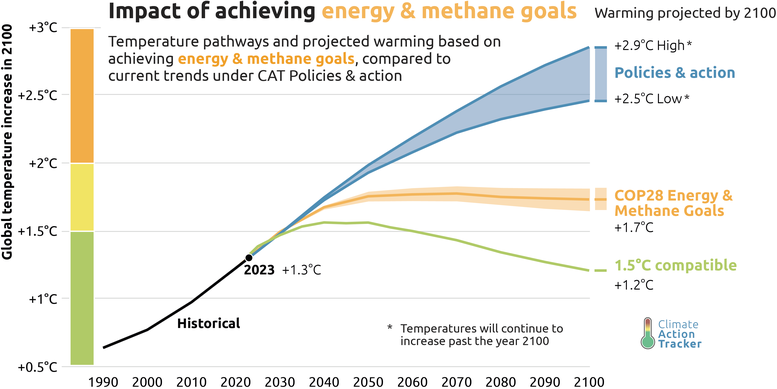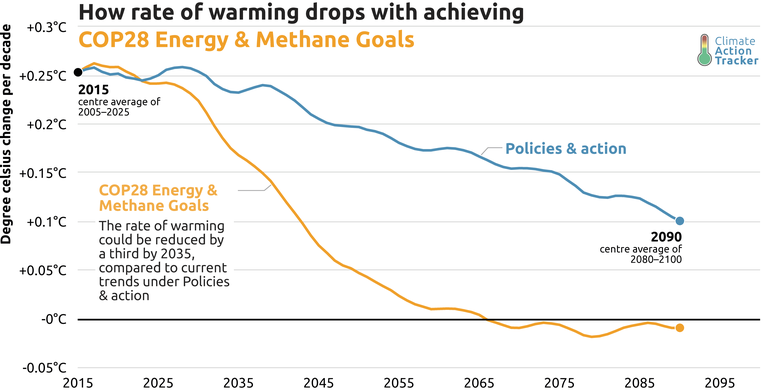RELEASE: three key near-term actions would bring projected warming below 2°C
Press release
Topline results:
- Tripling renewables, doubling energy efficiency and cutting methane by 2030 and beyond would cut warming rate by a third in ten years, and halve it by 2040.
- Implementing the tripling and doubling goals of the COP28 Global Stocktake (GST) would be the first critical step in the GST agreement to transition away from fossil fuels in energy systems.
- It would significantly cut projected warming this century (about 0.9˚C - from 2.6˚C to 1.7˚C)
- Scaled up financial support to achieve this will be needed for many poorer countries.
- Rapidly reducing the rate of warming is critical for adaptation.
If governments were to implement three key climate actions they already negotiated and agreed in 2023 - tripling renewables, doubling energy efficiency, and acting to reduce methane emissions by 2030 - they could cut global emissions by 18 billion tonnes in 2035 compared to current emission projections, according to new analysis released at COP30 today by the Climate Action Tracker.
If they continued this action, government would put the world on track to lower projected 21st century warming by about 0.9˚C, from 2.6˚C to 1.7˚C. This could be almost as much as the entire 1˚C improvement seen over the ten years since governments adopted the Paris Agreement and would be a massive step towards keeping the 1.5˚C limit in sight.
The analysis also finds that by taking these three actions between now and 2035 governments would reduce the rate of warming by a third in ten years and halve it by 2040, whereas the current warming rate is set to accelerate by 2030 before only slowly declining. Cutting the rate of warming would bring significant benefits for adaptation planning.
However, they would need to start now and continue taking strong action well beyond 2035.
At COP28 in Dubai, 2023, as part of the first full assessment of government action since the Paris Agreement - the first Global Stocktake (GST) - governments negotiated and agreed on a clear set of 2030 energy goals to align with limiting warming to 1.5°C. These included tripling renewable energy capacity, doubling the rate of energy efficiency improvements, and cutting methane emissions - referred to here as the COP28 Energy and Methane Goals.
"Two years ago, governments promised to triple renewable energy, double efficiency and act on methane. Our results show if they achieved this by 2035 it would be a gamechanger, quickly slowing the rate of warming in the next decade and lowering global warming this century from 2.6°C to about 1.7°C ," said Bill Hare, CEO and Senior Scientist at Climate Analytics, a CAT partner organisation. "Stopping deforestation would also need to be a critical step here.
"But governments need to start right now. The real question is political: can governments bring themselves to resist the pressure from the fossil fuel industry and will richer countries agree to accelerate financial support for those countries that need it?"
These goals form a central component of the COP30 Presidency's action agenda, and constitute the backbone of a feasible path to course-correct this decade, and rapidly speed up the transition away from fossil fuels. Alongside the three goals covered in the analysis is stopping deforestation, which would also have a major impact.
"In the ten years since Paris our outlook of warming by the end of the century improved by 1˚C, but emissions until 2030 keep stubbornly high. Tripling renewables, doubling efficiency and action on methane would significantly lower emissions by 2030 and if continued keep warming below 2°C" said Prof. Niklas Höhne of CAT partner organisation NewClimate Institute.
"This transition booster would lead to significantly less emissions in this century and therefore a much lower temperature increase. If governments were to implement what they already promised we could avert climate chaos, and ease the enormous pressure on adaptation."
The analysis evaluates the global benefits of governments taking concerted action to deliver on the COP28 Energy and Methane Goals by 2030 and 2035, both in terms of emission trajectories and warming implications.
Specifically the analysis takes a detailed look at what individual countries within the G20 can do for each of these goals, given the G20 accounts for around 80% of global emissions.
Tripling renewable energy within the G20 would account for roughly 40% of total emission reductions. Expanding renewables is the backbone of the energy transition as it delivers dual benefits: displacing fossil fuels directly and powering electrification across sectors, which in turn drives greater energy efficiency.
Doubling energy efficiency would contribute another 40% of the G20’s total reductions. Electrification of industry, buildings and transport is key to achieving this goal, making up almost half of the improvements.
Methane mitigation would deliver a further 20%, providing rapid, near-term benefits. These percentages would be roughly the same for the extrapolation at the global level.
Although the methane reductions are just 20% of the total emission reductions the warming benefit is much greater, contributing up to half of the reduction in the warming rate - methane and CO2 reductions work together to rapidly reduce the rate of warming.
Further efforts on the guidance provided by the Global Stocktake—such as halting deforestation by 2030—would yield additional climate benefits.
The delivery of these goals would require significant political commitment from governments which could be a strong outcome of COP30 in Belem, a step change in action, and a substantial increase in financial support for those countries who lack the resources to act at the scale required.
Stay informed
Subscribe to our newsletter

